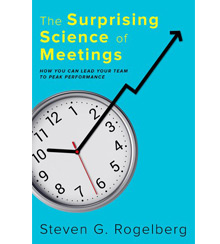Bad meetings no more
In his new book, UNC-Charlotte professor Steven Rogelberg offers an evidence-based guide to holding better meetings.
The Surprising Science of Meetings: How You Can Lead Your Team to Peak Performance
by Steven G. Rogelberg, Oxford University Press, 2019
Aldous Huxley had it wrong. Bad meetings — not mescaline — open the doors of perception. They lull me into a trance. I occasionally surface (did I snore?), murmur agreement (to who knows what), surreptitiously check my phone, and nod off again. If the deep breathing I often hear on conference calls is any clue, I’m not the only one who achieves spiritual transcendence in bad meetings.
The authors of how-to books about meetings never consider the salutary effects of bad ones. Instead, they typically start with an adrenalin-like shot of statistics. Steven Rogelberg, Chancellor’s Professor at University of North Carolina, Charlotte, and author of The Surprising Science of Meetings, is no exception to the rule. He offers the usual litany of dismay. There are about 55 million meetings per day in the U.S. alone, and they cost US$1.4 trillion annually, not counting indirect costs such as employee frustration. “Too many meetings” is cited as the top time-waster by 47 percent of U.S. workers.
“Too many meetings” is cited as the top time-waster by 47 percent of U.S. workers.
Nevertheless, Rogelberg doesn’t think that companies should eliminate meetings. “Was the great management guru Peter Drucker correct when he said, ‘Meetings are a symptom of bad organization. The fewer meetings, the better’?” Rogelberg asks. “The answer is an emphatic ‘no.’ Abolishing meetings is a false solution. Schedules with too few meetings are associated with substantial risks for employees, leaders, teams, and organizations.” Instead, the author advises breaking the cycle of bad meetings with the application of meeting science.
If anybody has a claim on the role of meeting scientist, it’s Rogelberg. He has been researching meetings using field surveys, laboratory studies, and experiments incorporating planted accomplices for 15 years. In this book, he weaves his findings and the research of others into an evidence-based approach to meetings that is sometimes eye-opening.
It isn’t surprising to hear that meeting leaders should take the time for a “reflection on the agenda, the goals, the order of topics, potential problems, dynamics, and useful strategies to try,” as well as the creation of psychologically safe spaces, before their meetings. But then, Rogelberg informs us that studies show that agendas don’t really improve meetings. He cites a 2003 study of senior leadership teams at 187 companies with market capitalizations of at least $1 billion, which found that the meeting agendas in half of the companies were either exactly the same from meeting to meeting or created in an ad hoc, spontaneous manner.
The solution: a purposefully constructed agenda. “When planning an event, we think carefully about the details, the flow, the experience, and the approach. The same mind-set and process should occur when planning a meeting,” Rogelberg writes. “It’s not unusual for a meeting to cost between $1,000 and $3,000 in attendee time and salaries, which many would say is fairly expensive even warranting careful planning.”
With regard to problem-solving meetings, Rogelberg finds that the “synergistic effect” of bringing people together to address a challenge does not manifest itself 85 to 90 percent of the time. In fact, he reports, that more than 80 studies have found that “participants who interacted during the meeting produced significantly fewer and lower-quality ideas than non-talking participants.” Worse, the larger the meeting, the more pronounced this effect.
Rogelberg’s counterintuitive advice to leaders who want to buck the odds is “less talking and more silence” in such meetings. He recommends using “brainwriting” instead of brainstorming: In brainwriting’s simplest form, the meeting participants write down their responses to an open-ended prompt, such as “What are one to three things we can do to improve our XYZ process,” without discussion. The responses are organized and posted on a wall, and the meeting participants vote on their favorites. “The entire process is noteworthy for being inclusionary, engaging, time-effective, and generally free from pressures to conform,” explains Rogelberg. (Having recently participated in a variation on this process with a group of about 50, I think so, too.)
Surprisingly, the book doesn’t directly call out my biggest meeting peeve: the unwillingness of participants to read materials that are distributed prior to the meeting, even when familiarity with the material is critical to the outcome of the meeting. Rogelberg does, however, recommend a technique used at Amazon that might help eliminate this problem. “Amazon initiated a pretty standard practice: ideas, concepts, and proposals had to be written down thoroughly. Meetings then begin with a silent period of time to read the fully self-contained document,” he writes. “This could be anywhere from 10 to 30 minutes and did not occur in advance of the meeting — it was part of the meeting itself.” Only then does discussion ensue.
Like most meeting books, The Surprising Science of Meetings offers a wealth of practical advice. But being a pessimist, I doubt that enough leaders will use it to actually improve the abysmal state of meetings overall. On the plus side, however, we’ll still get to enjoy the transcendental experiences triggered by bad meetings.
Author profile:
- Theodore Kinni is a contributing editor of strategy+business. He also blogs at Reading, Writing re: Management.





